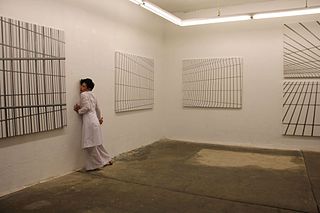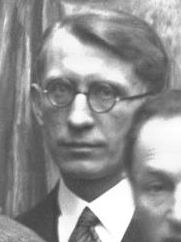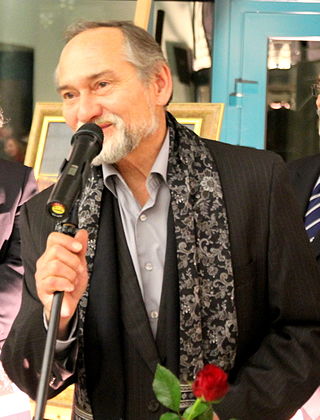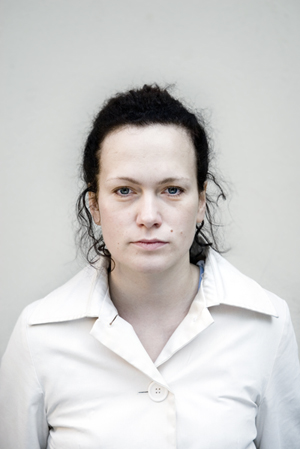Katarzyna Karpowicz | |
|---|---|
 | |
| Born | 4 November 1985 |
| Nationality | Polish |
| Education | Grzegorz Bednarski Leszek Misiak Academy of Fine Arts in Cracow |
| Known for | painting |
Katarzyna Karpowicz (4 November 1985) is a Polish contemporary painter.
Katarzyna Karpowicz | |
|---|---|
 | |
| Born | 4 November 1985 |
| Nationality | Polish |
| Education | Grzegorz Bednarski Leszek Misiak Academy of Fine Arts in Cracow |
| Known for | painting |
Katarzyna Karpowicz (4 November 1985) is a Polish contemporary painter.
Karpowicz was born in Kraków to Anna Karpowicz-Westner (maiden name Wiejak) and Sławomir Karpowicz (1952–2001), both painters. Her father was a professor of art at Cracow Academy of Fine Arts. Parents, together with their daughters Joanna and Katarzyna lived and painted in the studio on Piłsudzkiego Street previously owned by Olga Boznańska. [1] [2] [3] [4] In 2005 she graduated from art high school Państwowe Liceum Sztuk Plastycznych and began her studies at National School of Fine Arts in Cracow. Until 2008, she studied under Grzegorz Bednarski. [5] She graduated with honors in 2010 under Leszek Misiak. Katarzyna Karpowicz's works can be found in collections in Poland and abroad, as well as in the collection of the Museum of Contemporary Art in Gdansk. She lived and painted in Budapest (2013–2015) and later in England (2015–2016) in Pangbourne. She is a figurative painter. In 2019 she was awarded Anna Maria Siemieńska Grazella Foundation's artistic scholarship for young artists. She gave several interviews [6] [1] discussing her artistic heritage and musical taste. [7] In an interview in Magyar Nemzet a Hungarian art critic [8] talks about influences of Budapest on Karpowicz's art.
Between 2017 and 2019 she placed in top three of young Polish painters in a prestigious competition Young artist compass. [9] [10] Her art received positive comments from several independent art critics. Art critic Małgorzata Czyńska mentions [11] that her paintings combine childlike beauty and somewhat naïve trust, but are streaked with fear and the experience of the cruelty of fate. The same critic writes that Katarzyna Karpowicz's works are deeply universal and existential, revolving around relationships, expectations, hope and fears. [12] Samanta Belling indicates [13] that Karpowicz's works prove that there are still young artists who live for art and are able to create an atmosphere that evokes memories. She states that "Katarzyna Karpowicz seems to be out of this epoch, as if she were living beyond the time, just like her paintings. By deliberately simplifying the form of her work, she gives us room for impressions, guesses and personal interpretations." Kama Wróbel opines [14] that each new series of Karpowicz's work has deep meaning and provides a point of departure for multi-faceted consideration of the human condition. Art historian Stanisław Tabisz [15] writes about Karpowicz's fascinations with the circus in Budapest, solar eclipse observed with her father in their hometown of Szczebrzeszyn and youthful influences in her paintings. He goes on to state that "Katarzyna Karpowicz's paintings express, in their sincere and straightforward message, the connection of each of us with the world, of experiencing everything in a unique and exceptional way." Daniel Czepiński [16] writes that one finds oneself in Karpowicz's studio surrendered by magical trees, doors and openings which all lead to new worlds. Adam Szczuciński finds [17] captivating charm of the unknown in her paintings. He also writes in his essay A physician's viewpoint that Karpowicz's "powerful talent makes it truly impossible to remain indifferent to her small-sized images" and he concludes that "they infect the memory and stay like afterimages on the retina after we close our eyes." [18] Ewa Ogłoza [19] in art journal artPaper writes that she is enchanted with Katarzyna Karpowicz's paintings and delighted with her life attitude and art "characterized by gratitude, kindness, humility, seriousness, mindfulness and tenderness towards the world, people and culture". She states that Karpowicz loves to paint and looks for consolation and hope in art "by designing her own fears, hopes, dreams, she gives comfort to others".
Source: [12]
Source: [12]

Olga Boznańska was a Polish painter of the turn of the 20th century. She was a notable painter in Poland and Europe, and was stylistically associated with the French impressionism, though she rejected this label.

Jarosław Kukowski is a Polish contemporary painter, juror of international art competitions. His works were exhibited, among others Branch Museum of the National-Królikarnia Salons Rempex Auction House, the Museum of Galicia, the Contemporary Art Gallery, Castle Voergaard, the Art Expo New York and many other galleries and museums in the world. He is considered one of the most influential contemporary creators of the Surrealist circle.

Krzysztof Michał Bednarski (KMB) is a contemporary Polish-Italian sculptor.

Stanisław Masłowski was a Polish painter of realistic style, the author of watercolor landscapes.

Miho Iwata is a performance artist, scenographer and choreographer. In 1986 she emigrated to Kraków, Poland, where she lives and works. Her work is performed at theater and arts festivals throughout Poland and abroad.

Wojciech Korneli Stattler or Albert Kornel Stattler was a Polish Romantic painter of Swiss aristocratic ancestry, who started training in Vienna and at age 17 went to St. Luke's Academy in Rome. From 1831 he taught as professor at the School of Fine Arts in Kraków. 1850 he returned to Rome. His most famous pupil was Poland's leading painter of historical figures and events, Jan Matejko.

Dorota Dziekiewicz-Pilich is a Polish sculptor and drawing artist.
Zuzanna Janin, is a Polish visual artist and former teen actor. Janin lives and works in Warsaw and London. Janin has created sculpture, video, installation, photography and performatives. She used the names Zuzanna Baranowska (1990-1992) and from 1992 Zuzanna Janin. Her work was shown in the Museum of Contemporary Art, Chicago; and A.I.R Gallery New York. She is included in Feminist Artists Data in Brooklyn Museum, NY.
Kasia Pisarek is an art expert in London, specializing in Old Masters.

Samuel Finkelstein (1895–1942) was a Jewish oil painter in the interwar Poland who died at the Nazi death camp Treblinka during the Holocaust.

Anna Ziaja is a Polish contemporary painter and print maker.
Paweł Kowalewski – is a Polish artist, member of Gruppa collective, academic teacher, founder of the Communication Unlimited agency.

Ewa Kuryluk is a Polish artist. She is a pioneer of textile installation, painter, photographer, art historian, novelist and poet, and the author of numerous books, written in Polish and English, many of which have been translated into other languages. She has had over fifty solo exhibitions, participated in many group shows and created outdoor installations throughout the world. Her work can be seen in the National Museums in Warsaw, Kraków, Wrocław and Poznań, as well as in public and private collections in Europe, USA, Latin America and Japan.
Aleksander Żywiecki is a Polish painter specializing in realist landscape painting

Grzegorz Stec is a Polish painter, graphic artist and poet.

Magda Bielesz – painter, author of installations, objects, drawings, videos.
Dr. hab. Józef Grabski is a Polish born art historian, he is also a director of the Institute for Art Historical Research IRSA since its founding in 1979, also a publisher and editor-in-chief of Artibus et Historiae.

Małgorzata Turewicz Lafranchi is a visual artist. Born in Poland, since 1994 she has lived and worked in Bellinzona in the Ticino canton of Switzerland.

Sławomir Ratajski is a Polish painter and diplomat.
Hanna Zawa-Cywińska is a Polish contemporary abstract artist based in Warsaw.
(pl) Katarzyna zamyka w obrazach swój bardzo osobisty świat pomiędzy snem a jawą, techniką a marzeniem. (en: Katarzyna presents a personal world in her paintings, one that lies between dream and reality, technology and dreams.)
(pl) Znamy nazwiska najważniejszych polskich artystów młodego pokolenia mijającego roku. (en: Here are the names of the most important Polish artists of the young generation of the past year.)
Katarzyna Karpowicz's works are deeply universal and existential, centering on relationships, expectations, hope and fears. The girl who, years ago put her heroines at the foot of the mountain or a great bear, huddled like children in their mother's womb, and had the dream a dream of life, has become a woman. It is not without reason that masks appear so often in her paintings: the motif of playing and pretending, but even more the mature ability to cope in the world. And even if it is not immediately visible, there is a dose of humour, irony and tongue-in-cheek in all this lyricism.
(pl.) Dawno w kontakcie z malarstwem nie doznałam takiego olśnienia, jak przy zetknięciu się ze sztuką Katarzyny Karpowicz. Jej prace są dowodem na to, że są jeszcze młodzi artyści, którzy tworząc, żyją, a ich sztuka, to przede wszystkim uczucia i niepowtarzalna atmosfera, która prawie w każdym z nas przywołuje wspomnienia[..] Katarzyna Karpowicz wydaje się być nie z tej epoki, tak jakby żyła poza czasem i ponad czasem, podobnie jak jej malarstwo. Celowo upraszczając formę swoich prac, pozostawia nam miejsce na wrażenia, domysły, osobiste interpretacje. (en: It been a long time since I experienced such an enlightenment in contact with paintings as in contact with Katarzyna Karpowicz's art. Her works prove that there are still young artists who create, live, and their art is, above all, based on feelings and a unique atmosphere that evokes memories in almost all of us [..] Katarzyna Karpowicz seems to be out of this epoch, as if she were living beyond time, just like her paintings. By deliberately simplifying the form of her work, she leaves room for impressions, guesses and personal interpretation.)
)
Malarstwo Katarzyny Karpowicz, w swym szczczerym i prostolinijnym przesłaniu, mówi o łączności każdego z nas ze światem, o przeżywaniu wszystkiego w sposób niepowtarzalny i wyjątkowy. Czułe sekrety wyobraźni artystki zakorzenione są w obserwacji tego co ją otacza, co na nią oddziaływuje. (en: Katarzyna Karpowicz's paintings express, in their sincere and straightforward message, the connection of each of us to the world, and the aspect of experiencing everything in a unique and exceptional way. The tender secrets of the artist's imagination are rooted in the observation of what surrounds her and what influences her.)
The artist allows us -viewers - to create our own stories, guess at meanings, form our own conjectures. At times, one can discern colourful blots in the background, resembling traces of attempts at developing an image, conjuring figures out of nothingness and providing real frameworks to dreams. Allow me to add that these attempts are exceptionally successful.
(pl.) Zachwycają mnie obrazy Katarzyny Karpowicz, zachwyca postawa życiowa i sztuka artystki – nacechowana wdzięcznością, życzliwością, pokorą, powagą, uważnością i czułością wobec świata, ludzi oraz kultury [..]. Karpowicz kocha malarstwo, literaturę i film; w tym tkwi dla niej sens życia. Patrzy na siebie i maluje siebie, w sztuce szukając pociechy i nadziei, a przedstawiając siebie, projektując własne lęki, nadzieję, sny i marzenia, daje pociechę innym w podobnych sytuacjach (en.: I am enchanted with Katarzyna Karpowicz's paintings, I am delighted with the artist's life attitude and art – characterized by gratitude, kindness, humility, seriousness, mindfulness and tenderness towards the world, people and culture [..] Karpowicz loves painting, literature and film; this is the meaning of life for her. She looks at herself and paints herself, looking for consolation and hope in art, and by presenting her self, designing her own fears, hopes, dreams, she gives comfort to others in similar situations.)